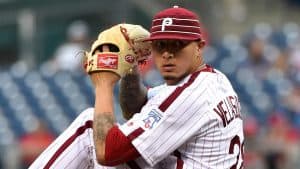

The Phillies are now 14-8, which is a good record. Now, 22 games isn’t a very large chunk of the baseball season (it’s just 13.5 percent), but hey, we can draw some conclusions about what we’ve seen so far, right?
Here are things we know now about the Phillies:
Wow, Tim, way to be bold. But look, this team isn’t the Astros (have you seen that pitching staff?). They’re not just good, but they are sometimes good and sometimes not so good. Which means initial predictions of 78-84 wins or whatever seems about right. Maybe they shock people, but that’s probably because the National League is weak this season. I’m not sure yet that it is, even with Washington injured and floundering. That’ll take more time to figure out.
I know, he gave up back-to-back home runs (to non-power hitters, no less) and couldn’t get out of that fifth inning last night. What I saw was a guy who rebounded after giving up those homers and had to fight nasty weather in the fifth. I don’t like ever using rainy pitching as an indicator of success, as there are too many variables thrown into the fire. Now, that said, Velasquez doesn’t look like a top-line starter, but there’s definitely a better approach there. He is giving up more hits, but the walks are down, and I’ll trust the Phils to make the right defensive adjustments and plays to keep the contact outcomes to a minimum.
There may be nothing I loathe more in baseball than a guy who swings at the first pitch after the pitcher walked a hitter, and it feels as if the Phils did that 1,000 times last season. So I love that this team takes pitches, leading baseball in pitches per plate appearance (4.23). It doesn’t always mean better outcomes (this team strikes out a lot), but it doesn’t hurt to see as many pitches as possible while wearing down pitchers. It also means baserunners when you’re not hitting the ball. Sometimes that works out.
Both of these things can be true. The fact that the team strikes out a lot is a problem, because they’re not putting the ball in play enough and forcing fielders to make plays. Here are some strikeout ratios: 46.2% (Jorge Alfaro), 35.7% (Andrew Knapp), 30.8% (Nick Williams), 30.5% (Scott Kingery). Those are the ones far above league average. Some of that needs to change.
That said, the team batting average of .229 seems low, but it’s only ninth of 15 National League teams. This year, so far, contact is down, averages are down, strikeouts are up and walks are up.
The team’s general strategy seems to be this: Work counts, look for balls to hit in the air, get big hits. Over an entire year (as weather warms and pitchers cycle in and out and hitters get more reps), this may bear out. Maybe this is a league-average offense with more extra-base hits and walks than other teams. But right now the Phils are 13th in the NL in home runs. Right now the strategy is not working completely (it would be nice if one of these sub-.250 guys gets the bat going). Maybe it will! But right now it’s not.
I know, you hate hearing that. But April 25 is (checks watch) still early. Carlos Santana has started the season 12-for-78, which isn’t optimal. But let’s say, over the next 78 at-bats, he doubles that up with 24 hits, or a .307 average (which is actually a normal thing to do). His average is then .230. No, not really optimal either, but Santana was a .249 hitter in Cleveland. Yes, just .249. His forte isn’t average but getting on base and driving in runs. I am confident he does that. It may not be in droves until summer, when the weather warms and he’s comfortable and seeing more pitches, but I am confident.
Yacksel Rios didn’t pitch well last night, but again, last night is not an indicator of anything to me, so I’ll take away his 1.1 IP, 3 H, 3 R, 1 K, 1 BB performance. Thus, he’s thrown seven innings (small sample) with eight hits allowed and three walks allowed. He has also struck out a batter per inning.
But while those numbers would probably be fine on some bullpens, the Phils group is pretty strong. When Pat Neshek returns, Rios is probably moving to Lehigh Valley (and is the early leader in the Mr. Northeast Extension 2018 race).
When Mark Leiter Jr. returns, Mark Hutchison is probably heading somewhere else, too. So the bullpen will be this: Neris / Garcia / Hunter / Neshek / Ramos / Morgan / Arano / Leiter Jr.
And Victor Arano has seriously deserved the opportunity to pitch in higher leverage situations.